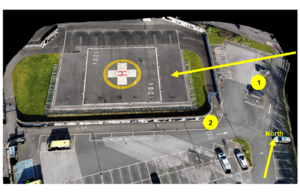AAIB Formal Report: Sikorsky S-92A (G-MCGY), Fatal accident, 4 March 2022
Several members of the public were subjected to high levels of downwash from the approach and landing of a search and rescue helicopter. One person suffered fatal injuries and another was seriously injured.

Helicopter Landing Site
Summary
The helicopter, G-MCGY, was engaged on a Search and Rescue mission to extract a casualty near Tintagel, Cornwall and fly them to hospital for emergency treatment. The helicopter flew to Derriford Hospital, Plymouth, which has a Helicopter Landing Site (HLS) located in a secured area within one of its public car parks. During the approach and landing, several members of the public in the car park were subjected to high levels of downwash from the landing helicopter. One person suffered fatal injuries and another was seriously injured.
Investigation findings
The investigation identified two causal factors for this accident:
- The persons that suffered fatal and serious injuries were blown over by high levels of downwash from a landing helicopter when in publicly accessible locations near the Helicopter Landing Site
- Whilst helicopters were landing or taking off, uninvolved persons were not prevented from being present in the area around Derriford Hospital’s Helicopter Landing Site that was subject to high levels of downwash.
The following contributory factors were also identified:
1. The HLS at Derriford Hospital was designed and built to comply with the guidance available at that time, but that guidance did not adequately address the issue of helicopter downwash.
-
The hazard of helicopter downwash in the car parks adjacent to the HLS was not identified, and the risk of possible injury to uninvolved persons was not properly assessed.
-
A number of helicopter downwash complaints and incidents at Derriford Hospital were recorded and investigated. Action was taken in each case to address the causes identified, but the investigations did not identify the need to manage the downwash hazard in Car Park B, so the actions taken were not effective in preventing future occurrences.
-
Prior to this accident, nobody at Derriford Hospital that the AAIB spoke to was aware of the existence of Civil Aviation Publication (CAP) 1264, which includes additional guidance on downwash and was published after the HLS at Derriford Hospital was constructed. The document was not retrospectively applicable to existing HLS.
-
The operator of G-MCGY was not fully aware of the Derriford Hospital HLS Response Team staff’s roles, responsibilities, and standard operating procedures.
-
The commander of G-MCGY believed that the car park surrounding the Derriford Hospital HLS would be secured by the hospital’s HLS Response Team staff, but the co‑pilot believed these staff were only responsible for securing the HLS.
-
The Derriford Hospital staff responsible for the management of the HLS only considered the risk of downwash causing harm to members of the public within the boundary of the HLS and all the mitigations focused on limiting access to this space
-
The Derriford Hospital staff responsible for the management of the HLS had insufficient knowledge about helicopter operations to safely manage the downwash risk around the site.
-
The HLS safety management processes at Derriford Hospital did not result in effective interventions to address the downwash hazard to people immediately outside the HLS.
-
HLS safety management processes at Derriford Hospital did not identify that the mitigations for the downwash hazard were not working well enough to provide adequate control of the risk from downwash.
-
Communication between helicopter operators and Derriford Hospital was ineffective in ensuring that all the risks at the Derriford Hospital HLS were identified and appropriately managed.
-
Safety at hospital HLS throughout the UK requires effective information sharing and collaboration between HLS Site Keepers and helicopter operators but, at the time of the accident, there was no convenient mechanism for information sharing between them.
Safety action and recommendations
Following this accident, safety action was taken by the helicopter operator, Derriford Hospital and NHS England Estates to control and mitigate the risk. Additional action by Derriford Hospital and NHS England Estates to improve safety is either planned or in progress.
Helicopters used for Search and Rescue and Helicopter Emergency Medical Services (HEMS) perform a vital role in the UK and, although the operators of these are regulated by the UK Civil Aviation Authority, the many helicopter landing sites provided by hospitals are not. It is essential that the risks associated with helicopter operations into areas accessible by members of the public are fully understood by the Hospital Landing Site Keepers and that effective communication between all the stakeholders involved is established and maintained. Therefore, nine Safety Recommendations have been made to address these issues.
Chief Inspector’s statement
Crispin Orr, Chief Inspector of Air Accidents said:
“This was an unusual and distressing accident in which an aircraft undertaking a mission to save life, sadly also resulted in the death of an uninvolved person and serious injury to another, who were blown over by high levels of downwash from a landing helicopter.
“Our in-depth investigation revealed systemic safety issues around the design and operation of hospital helicopter landing sites which need to be addressed at a national level. Helicopters used for search, rescue and emergency medical services play a vital role, but it is essential that the risks associated with helicopter downwash are understood and well-managed.
“The investigation has raised awareness of this issue and been a catalyst for important safety action, which has been taken to mitigate the immediate risk. In addition, nine recommendations have been made in this report to help improve coordination between the aviation and NHS stakeholders, to ensure the protection of uninvolved persons from helicopter operations at hospital helicopter landing sites across the UK.”